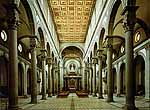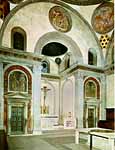
The Church of St. Lorenzo
 Part One
Part One
Excusez nous mais cette page n'est pas été encore
traduite en Français
The Renaissance began to utilize the classical ideas and forms again in
the arts, following the cultural ideals of continuation with the ancient
world. Over a period of a few short years, an architect (Brunelleschi), a sculptor (Donatello) and a painter
(Masaccio) carried out a revolutionary transformation
in Florence of the conceptions and the functions of creative activity. Art
was no longer a "mechanical activity", or a sort of handcraft,
but a "liberalis", or rather, an intellectual exercise. This transition
was confirmed by the publication of several theoretical works by Leon Battista Alberti: "De pictura" (1436)
dedicated to Filippo Brunelleschi, "De
re aedificatoria"
(1452) e "De statua" (1464).
Art became an instrument of knowledge and research into reality;
it was a real science based on rational theoretical foundations,
like the rules of perspective. The key-concept of the "imitation
of nature" was based on the contrast between classical and Byzantine
traditions but should also be understood as the mathematical and
geometrical organization of visual data (the object of the painting)
within a given space (a panel or wall to be frescoed).

The Old Sacresty
at San Lorenzo
This artistic rebirth (through the patronage of the rich) spread and developed, reaching the greatest heights of "Classicism" with Bramante, Michelangelo and Leonardo. The artists that followed Raphael and Michelangelo (who as a boy lived in Lorenzo the Magnificent's house and in the gardens of St. Mark ) with Poliziano and other humanists) developed Mannerism into a nonconformist search for pure originality as a reaction to the anxiety that transpired behind the veils of Classicism.
